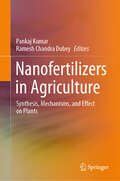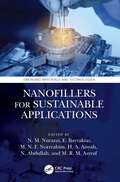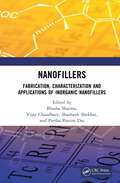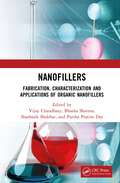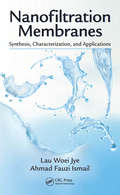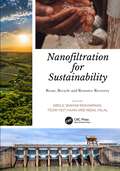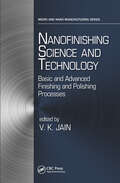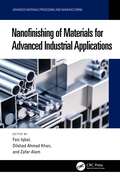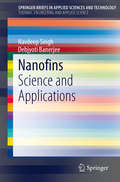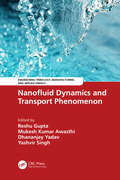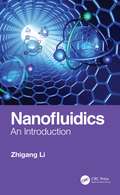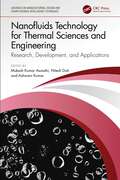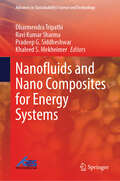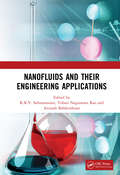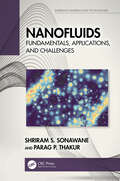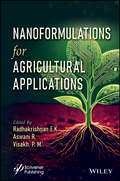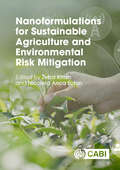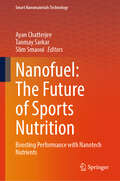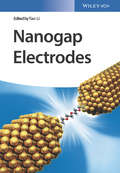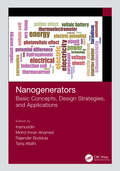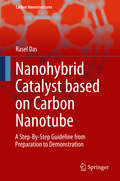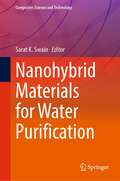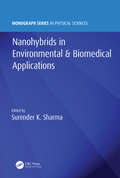- Table View
- List View
Nanofertilizers in Agriculture: Synthesis, Mechanisms, and Effect on Plants
by Pankaj Kumar Ramesh Chandra DubeyThis book covers the role and effects of nanofertilizers in agriculture and together with its companion book “Nanofertilizers for Sustainable Agriculture: Assessing Impacts on Health, Environment, and Economy” serves as an indispensable resource for researchers, agronomists, and policymakers exploring sustainable agriculture with nanotechnology. The book outlines the synthesis and formulation of nanoparticles tailored for agricultural applications and discusses the impact of nanofertilizers on crop well-being and soil fertility, including the pivotal role of plant growth-promoting microorganisms in nanoparticle-mediated agriculture. Divided into four sections, the book begins with an introduction to the relevance and specificities of nanotechnology in agriculture, including nonfertilizer synthesis and formulation, followed by a section dedicated to rhizosphere microorganisms and the impact of nanofertilizers in agricultural systems. Readers will learn about the impact of nanofertilizers on crop well-being and soil fertility, including the pivotal role of plant growth-promoting microorganisms in nanoparticle-mediated agriculture. The subsequent section of the book is devoted to the mechanisms of action of nanofertilizers, namely the ones governing the release, absorption, and translocation of nanonutrients in soil, and discusses the potential of biocatalysis in nanofertilizer development. The final section of the book discusses crop productivity and biofortification while unravelling the nuanced effects of nanoparticle doses, shapes, sizes, and compositions on crop yields and physiological activities. In this section, readers will also find diverse applications of nanofertilizers in stress tolerance, salinity, and environmental stress mitigation.
Nanofillers for Sustainable Applications (Emerging Materials and Technologies)
by N. M. NurazziNanofillers for Sustainable Applications provides an in-depth review of the wide-ranging applications of nanofillers. It explores both synthetic and natural nanofillers and focuses on their use as reinforcement and active fillers in composite structures. Covering various aspects of nanofillers, including synthesis methods, characteristics, properties, and compatibility, this book highlights the potential of nanofillers as functional materials for different applications and offers a collection of comparative studies to showcase their efficacy. It emphasizes sustainability, intelligent design, and high-end applications in fields such as packaging, pulp and paper, aerospace, automotive, medicine, chemical industry, biodiesel, and chemical sensors. This book is organized into several sections, covering topics such as synthetic nanomaterials, nanosafety, natural nanofillers, polymer composites, metal nanofillers, nanofillers in various industries, nanofillers in renewable energy, nanofillers in biomedical sectors, and nanofillers in automotive and aerospace industries. This book will be a useful reference for undergraduate and graduate students and academic researchers in the fields of materials science, nanomaterials, and polymer composites. Key features: • Focuses on the fabrication approaches used for nanofillers in nanocomposites. • Covers materials selection, design solutions, manufacturing techniques, and structural analysis, highlighting their potential as functional materials in different applications. • Explores the positive environmental impact and material property improvements resulting from increased composite utilization across diverse industries. • Discusses other types of nanofillers like nanocellulose, metal-based, graphene, and wood-based materials. • Includes case studies from leading industrial and academic experts.
Nanofillers: Fabrication, Characterization and Applications of Inorganic Nanofillers
by Shashank Shekhar Partha Pratim Das Bhasha Sharma Vijay ChaudharyAnalyzing the modifying effects of various inorganic nanofillers on the mechanical properties of polymer nanocomposites, this book covers processing, characterization, properties, and applications to analyze how these materials allow for innovative multifunction. This volume looks at various synthesis methods available within inorganic nanofillers and what characterizes them, covering design, manufacturing processes, and end-user results. The chapters focus on metal oxides, energy storage, and devices, alongside polymers used for packaging. This book details the role inorganic nanofillers have to play in cost-effective manufacturing processes due to their strength and efficiency, and their subsequent relevance to low-cost yet high-performance materials. Covering topics such as corrosion resistance, wear resistance, strength, and characterization, this book is an essential companion for any engineer working with inorganic nanofillers. This book will be of interest to engineers involved with inorganic nanofillers in a variety of industries, including automotive, aerospace, and biomedical engineering.
Nanofillers: Fabrication, Characterization and Applications of Organic Nanofillers
by Shashank Shekhar Partha Pratim Das Bhasha Sharma Vijay ChaudharyThis book explores the modifying effects of various nanofillers on mechanical and physical properties of polymer nanocomposites. Looking at the four basic aspects of processing, characterization, properties, and applications, it analyzes how their features can allow for innovative multifunction within industry. Covering design, production, and manufacture, this book focuses on meeting end-use requirements and the fabrication of materials. The importance of mindful design and the use of an appropriate synthesis method is the primary lens through which theory and practice are discussed. This volume looks at the various synthesis methods available for organic nanofillers and what characterizes them. Properties including mechanical, thermal, electrical, and tribological are thoroughly examined, along with the various computational techniques used to determine them. With important sustainable properties, nanofillers are essential to meeting the increasing demand for biodegradable and environmentally friendly materials. This book details the role nanofillers have to play in sustainability, alongside economic factors such as efficient manufacturing processes. This book will appeal to both academic and industrial engineers involved with nanofillers in a variety of industries, including automotive, aerospace, and biomedical engineering.
Nanofiltration Membranes: Synthesis, Characterization, and Applications
by Ahmad Fauzi Ismail Lau Woei JyeCovering fabrication, characterization, and applications nanofiltration (NF) membranes, this book provides a comprehensive overview of the development of NF membrane technology over the past decade. It uniquely covers a variety of fabrication techniques, comparing the procedures of each technique to produce polymeric membranes of different morphologies. The book also discusses advances in the materials used in thin film composite (TFC) polyamide membrane fabrication and their influences on properties with respect to structural and separation characteristics. A comprehensive review on NF characterization methods and techniques is provided, assessing physical and chemical properties and separation characteristics and stability. Technical challenges in fabricating a new generation of NF membranes are also reviewed and the possible approaches to overcome the challenges are provided. The book concludes with relevant case studies on the use of NF membranes in industrial implementation of both aqueous and nonaqueous media. Details the latest progress on the fabrication techniques of asymmetric and composite NF membranes. Discusses characterization methods used in assessing membrane physical/chemical properties, separation characteristics, and performance stability. Describes the potential of advanced materials in improving properties of polyamide selective layer as well as microporous substrate. Reviews the technical challenges in fabricating a new generation of composite membrane—thin film nanocomposite (TFN) membrane—possible approaches to overcome challenges. Offers case studies on the applications of NF membranes for both aqueous and nonaqueous media.
Nanofiltration for Sustainability: Reuse, Recycle and Resource Recovery
by Abdul Wahab MohammadThis book provides a novel exploration of the application of nanofiltration membrane technology for sustainability in various industries, situated in view of recent breakthroughs and the use of reuse, recycle and resource recovery approaches. Moving from a comprehensive discussion of nanofiltration membrane processes to case studies and real-world applications of nanofiltration technology across society, both successes and potential limitations are considered. Features: Detailed discussion of the fundamentals of nanofiltration technology The concepts of reuse, recycle and resource recovery using nanofiltration technology are explored in combination with other technologies to advance circular economy Considered across a range of industries, such as textiles, oil, gas, agriculture and pharmaceutics Written in a thoroughly detailed manner, this book is an essential guide for industry professionals interested in sustainability and working toward a circular economy. Comprehensive discussions of the fundamental processes underpinning nanofiltration technology also make this book particularly appealing to students of industrial chemistry.
Nanofinishing Science and Technology: Basic and Advanced Finishing and Polishing Processes (Micro and Nanomanufacturing Series)
by V. K. JainFinishing is the final operation after a part is sized and shaped. Currently in high tech industries, there is a demand for nano level surface finishing of components. This process is done to improve the surface finish, to remove the recast layer, or to remove surface and sub-surface defects. The result is low friction, longer product life, and low power requirements. Equally important is the aesthetic aspect of the product. This subject is growing very fast from the technology as well as a science point of view. Books on this subject are very limited, particularly those ones that deal with both the science as well as the technology aspects.
Nanofinishing of Materials for Advanced Industrial Applications (Advanced Materials Processing and Manufacturing)
by Zafar Alam Faiz Iqbal Dilshad Ahmad KhanThis book details nanofinishing techniques employed for finishing of industrial applications in a comprehensive manner. It provides an introduction into nanofinishing requirements and basic nanofinishing techniques and their variants and details the latest developments, research and innovation, and advancements. It includes topics ranging from working principles, material removal mechanisms, force analysis, and mathematics involved in industry-specific applications, salient features, comparative study, and automation and optimization in nanofinishing technologies.This book: Explains cutting-edge nanofinishing technologies comprehensively, Discusses numerical explanations for better selection of process parameters and their modelling and optimization, Provides application-oriented aspects of nanofinishing processes, Explains processes considering Industry 4.0 capabilities and green manufacturing, Focuses on applications with good relevance to industry and coverage of case studies. This book is aimed at graduate students and researchers in manufacturing and process engineering, and the die and mould industries.
Nanofins
by Navdeep Singh Debjyoti BanerjeeNanofins Science and Technology describes the heat transfer effectiveness of polymer coolants and their fundamental interactions with carbon nanotube coatings that act as nanofins. Heat transfer at micro/nano-scales has attracted significant attention in contemporary literature. This has been primarily driven by industrial requirements where significant decrease in the size of electronic devices/chips with concomitant enhancement in the heat flux have caused challenging needs for cooling of these platforms. With quantum effects kicking in, traditional cooling techniques need to be replaced with more effective technologies. A promising technique is to enhance heat transfer by surface texturing using nanoparticle coatings or engineered nanostructures. These nanostructures are termed as nanofins because they augment heat transfer by a combination of surface area enhancement as well as liquid-solid interactions at the molecular scale.
Nanofluid Dynamics and Transport Phenomenon (Engineering Tribology, Manufacturing and Applied Energy)
by Mukesh Kumar Awasthi Yashvir Singh Reshu Gupta Dhananjay YadavThe text offers a detailed presentation of mathematical, numerical, and experimental techniques for nanofluids. It further covers the synthesis, characterization, stability, and heat transport. The book comprehensively discusses topics such as the comparison of heat transfer models, flow features of ternary hybrid nanofluids, thermodynamics and mass diffusion, and natural convection in triangular cavities.This book: Emphasizes the enhancement of heat transfer processes through nanoparticles, extending beyond heat transfer to applications in renewable energy. Explores the applications of nanofluids in enhancing food processing and agricultural practices. Covers thermal instability of couple-stress on viscous-elastic nanofluid flow and natural convection in a triangular cavity. Explains concepts including nanofluid-based energy storage, mass diffusion, thermodynamics, and nanofluid synthetic techniques. Presents topics such as numerical methods, fluid dynamics simulation, magnetohydrodynamics, heat and mass transfer, and radiation. It is primarily written for senior undergraduates, graduate students, and academic researchers in the fields of mechanical engineering, aerospace engineering, automotive engineering, industrial and production engineering, energy engineering, fluid dynamics, and tribology.
Nanofluidics: An Introduction
by Zhigang LiThis book provides an introduction to nanofluidics in a simple manner and can be easily followed by senior undergraduate students, graduate students, and other researchers who have some background in fluid mechanics. The book covers the main topics about the fundamentals of nanofluidics and how it differs from classic fluid mechanics. It also describes the methodologies of nanofluidics, including numerical approaches, e.g., molecular dynamics simulation and experimental techniques. Fundamental physics and new phenomena in nanofluidics are the major concerns of this book. The author goes on to discuss nanocofinements and the parameters that affect the fluid dynamics at the nanoscale and make flow analysis complex. These parameters accommodate rich, new flow phenomena that may not be observed at the macro- and microscale. Although not all of the new phenomena will find widespread applications, the physics underlying these new phenomena may offer insights for other fields. This is one of the reasons why this book emphasizes the mechanisms of various flow fashions. Explores the unique characteristics of nanoscale flows and related properties Reviews the latest research of nanoscale ion transport and its applications Discusses the fluid flows in nanoconfinements in a unique manner based on the author's original research Incorporates important applications of nanofluidics throughout.
Nanofluids Technology for Thermal Sciences and Engineering: Research, Development, and Applications (Advances in Manufacturing, Design and Computational Intelligence Techniques)
by Ashwani Kumar Mukesh Kumar Awasthi Nitesh DuttThis text highlights how nanofluids can be used in thermal solutions across multiple industries, including electronics, energy, and manufacturing. It emphasizes the enhanced heat transfer properties of nanofluids and their potential to significantly improve the efficiency of heat exchange processes. This book discusses topics such as nanoparticle synthesis, nanofluid testing, performance enhancement using nanofluids, thermal behavior of hybrid nanofluids, Brinkman equation in nanofluids and safety considerations in nano fluid‑based systems.This book:• Discusses the recent innovation, technological development of nanofluids and explores nanoparticle synthesis and characterization for nanofluid development.• Offers a comprehensive understanding of nanofluid technology and nanofluid for aerospace application, covering diverse topics from fundamental properties to advanced research frontiers in nanofluids for thermal engineering.• Includes real‑world case studies and practical techniques that will help the readers to apply nanofluid technology in various thermal engineering scenarios.• Covers heat exchanger performance improvement with nanofluids, hybrid nanofluids, Flow of Newtonian and Non‑Newtonian hybrid Nanofluid, and oil‑based Tri‑hybrid Nanofluid.• Explains experimental techniques for nanofluid testing and validation and presents safety and environmental considerations in nanofluid‑based systems.It is primarily written for senior undergraduates, graduate students, and academic researchers in the fields of manufacturing engineering, industrial engineering, production engineering, mechanical engineering, automotive engineering, and aerospace engineering.
Nanofluids and Nano Composites for Energy Systems (Advances in Sustainability Science and Technology)
by Pradeep G. Siddheshwar Dharmendra Tripathi Ravi Kumar Sharma Khaleed S. MekheimerThis book presents a very useful and easily comprehensible/valuable collection of experimental and mathematical studies on nanofluids, nanocomposites, and addresses current and future applications. This book serves as a ready reference for researchers working in the areas of dynamics of nanofluids. This book points toward technical expansions linked with energy, nanotechnology applications, energy storage, solar photovoltaic, and other related areas. This book provides insights related to various forms of applications in renewable energy systems and other industrial applications.
Nanofluids and Their Engineering Applications
by Avinash Balakrishnan Tubati Nageswara Rao K.R.V. SubramanianNanofluids are solid-liquid composite material consisting of solid nanoparticles suspended in liquid with enhanced thermal properties. This book introduces basic fluid mechanics, conduction and convection in fluids, along with nanomaterials for nanofluids, property characterization, and outline applications of nanofluids in solar technology, machining and other special applications. Recent experiments on nanofluids have indicated significant increase in thermal conductivity compared with liquids without nanoparticles or larger particles, strong temperature dependence of thermal conductivity, and significant increase in critical heat flux in boiling heat transfer, all of which are covered in the book. <P><P>Key Features Exclusive title focusing on niche engineering applications of nanofluids Contains high technical content especially in the areas of magnetic nanofluids and dilute oxide based nanofluids Feature examples from research applications such as solar technology and heat pipes Addresses heat transfer and thermodynamic features such as efficiency and work with mathematical rigor Focused in content with precise technical definitions and treatment
Nanofluids for Heat Exchangers
by Abdul Wahab Hafiz Muhammad Ali Ali HassanThis book describes the importance of heat transfer in heat exchangers, and fluids properties play a vital role to increase heat transfer rate translating the size of the equipment and cuts in the capital and running cost in the long term. Nanofluids applications in heat exchangers will help to improve the thermophysical properties of the fluid and therefore heat transfer. And, this book explains the enhancing mechanisms of heat transfer by employing nanofluids in heat exchangers. A critical discussion will enable to estimate the pros and cons of such fluids in different types of heat exchangers. Prevailing working conditions for short- and long-term implementation of various types of nanofluids will be discussed and introduced to the readers. This book helps the researchers, scientist and academicians working in the domain to be able to get a comprehensive knowledge at one place regarding the preparation, properties, measurements, data reduction, characteristics and applications of nanofluids in heat exchangers.
Nanofluids: Fundamentals, Applications, and Challenges (Emerging Materials and Technologies)
by Shriram S. Sonawane Parag P. ThakurNanofluids provides insight to the mathematical, numerical, and experimental methodologies of the industrial application of nanofluids. It covers the fundamentals and applications of nanofluids in heat and mass transfer. Thoroughly covering the thermo-physical and optical properties of nanofluids in various operations, the book highlights the necessary parameters for enhancing their performance. It discusses the application of nanofluids in solar panels, car radiators, boiling operations, and CO2 absorption and regeneration. The book also considers the numeric approach for heat and mass transfer and applications, in addition to the challenges of nanofluids in industrial processes. The book will be a useful reference for researchers and graduate students studying nanotechnology and nanofluids advancements within the fields of mechanical and chemical engineering.
Nanoformulations for Agricultural Applications
by Visakh P. M. Radhakrishnan E. K. Aswani R.This book is a comprehensive guide to nanoformulations revolutionizing agriculture, enhancing sustainability, and advancing agrochemical applications. This book examines state-of-the-art research, emerging challenges, and new opportunities in the field of nanoformulations for agriculture applications. Detailed discussions include the development and use of nanopesticides, nanoformulations for promoting plant growth, and nanotechnology for effective crop disease management. Furthermore, it covers recent trends in the design and production of nano-based formulations and nanocarriers for the efficient delivery of agrochemicals. The book is divided into three sections. The first section introduces readers to agricultural applications and methods for nanoparticle synthesis, their applications, and types of biomasses. It examines the benefits of agriculture and the role of nanotechnology in the agriculture sector. The second section focuses on nanoformulations for plant growth promotion. It covers topics on types of nanoparticles, synthesis methods of nanoparticles, and applications of nanoparticles in the agricultural field. The third section discusses trends, various other applications, and the benefits of using nanocarriers in agriculture. Audience This book is aimed at researchers, engineers and scientists working in agrochemicals, crops, soil, biotechnology (chemistry), microbiology, nano-chemistry/technology/materials/formulations in agriculture applications.
Nanoformulations for Sustainable Agriculture and Environmental Risk Mitigation
by Monica Popescu Anda Maria Baroi Mirela Florina Calinescu Georgiana Cîrstea Dobrescu Codruta Mihaela Dorobat Leonard Magdalin Oana Alexandra Draghiceanu Eladl Eltanahy Irina Fierascu Radu Claudiu Fierascu Rauzah Hashim Amany Saad Hegazy Khairul Anwar Ishak Dilki Jayathilaka K. G. Kaushani Nilwala Kottegoda Neblea Monica Angela Daniela Nicuta Alina Ortan Yehia A Osman Gheorghe Cristian Popescu Gayan Priyadarshana Ahmed A Razak Ana-Maria Rosu Chanaka Sandaruwan Ionela Daniela Khaled Sayed-Ahmed Yasser M Shabana Liliana Cristina Soare Gayanath Thiranagama Camelia Ungureanu Denisa Stefania Vîlcoci Diana Vizitiu Roxana-Elena VoicuNanotechnology research and its application in agriculture has become a major focus in recent years. Nanoformulations offer the possibility to develop more efficient and less damaging agrochemicals in the environment. Smart delivery systems for nanosensors, molecules that can help to detect biotic or abiotic stresses before they can affect production, are being developed and applied. Nanotechnology also provides new techniques for genetic manipulation and plant breeding. The use of nanoformulations in agriculture is increasingly being used to enhance food values, reduce agricultural inputs, improve nutrient contents and create a longer shelf life for many products. Nanotechnology is also being applied to many aspects of food security, disease treatment, new tools for pathogen detection, effective delivery systems and packaging materials. All of these applications are supposed to assist in addressing the needs of a growing population, and help in mitigating the effects of climate change and other ecological disturbances. This book highlights new applications of these nanoforms in the field of agricultural science, written by an international team of experts from across this broad discipline. It is essential reading for graduate students, researchers and practitioners involved in the application of nanotechnology in agriculture. The book: · examines the role of nano-formulations in crop yield improvement whilst reducing reliance on chemical fertilizers and pesticides; · covers specially enabled delivery systems for the release of nanoformulations, field-sensing systems to monitor environmental stresses, and improvement of plant traits against environmental stress and diseases; · is unambiguous, lucid, scientific and precise, with chapters supplemented by ample illustration and case studies to help clarify and summarize key points throughout.
Nanofuel: Boosting Performance with Nanotech Nutrients (Smart Nanomaterials Technology)
by Ayan Chatterjee Tanmay Sarkar Slim SmaouiThis book provides a groundbreaking exploration of how nanotechnology is revolutionizing sports nutrition. Offering a blend of cutting-edge science and practical applications, it reveals how nano-enhanced nutrients can optimize athletic performance, recovery, and overall health. The book aims to solve the problem of inefficient nutrient delivery in sports supplements. It provides readers with scientifically backed insights into how nanotechnology can overcome these challenges, offering practical solutions for athletes and sports nutrition professionals. Targeted at sports nutritionists, athletic trainers, researchers, and health-conscious athletes, this book is an essential resource for anyone interested in the future of sports nutrition and the transformative potential of nanotechnology.
Nanogap Electrodes
by Tao LiUnique in its scope, this book comprehensively combines various synthesis strategies with applications for nanogap electrodes. Clearly divided into four parts, the monograph begins with an introduction to molecular electronics and electron transport in molecular junctions, before moving on to a whole section devoted to synthesis and characterization. The third part looks at applications with single molecules or self-assembled monolayers, and the whole is rounded off with a section on interesting phenomena observed using molecular-based devices.
Nanogenerators: Basic Concepts, Design Strategies, and Applications
by InamuddinThis book provides an in-depth review of the history, fundamental theory, design strategies, and applications of nanogenerators. Working principles, device mechanisms, material characteristics, types of nanogenerators, and their different uses are fully explored.Top researchers in the field of sustainable technology from different backgrounds and fields contribute their expertise to deliver a must-have practical resource for students, academic researchers, and industry professionals.FEATURES Describes the fundamental aspects and theory of nanogenerators Explores design strategies including material assessment based upon planned application Tailors the introduction and essential concept discussion for the industrial and research community Explores current applications, existing challenges, and the future outlook for the field
Nanohybrid Catalyst based on Carbon Nanotube: A Step-By-Step Guideline from Preparation to Demonstration (Carbon Nanostructures)
by Rasel DasThis book introduces carbon nanotubes as a matrix for efficient nanohybrid catalysis. The preparation and use of such materials in ultra-grade water purification is described. Simple chemical methods for purification and functionalization of carbon nanotubes prior to their use is also detailed. The author also discusses the potential use of nanotube-based nanobiohybrid catalysts in the removal of organic pollutants.
Nanohybrid Materials for Treatment of Textiles Dyes (Smart Nanomaterials Technology)
by Mohammad Jawaid Akil Ahmad Mohamad Nasir Mohamad Ibrahim Asim Ali Yaqoob Mohammed B. AlshammariThis book covers the various aspects of nanohybrid materials and its composites for their application in treatment of toxic textiles dyes for cleaning the environment especially water and wastewater. The book first looks into the various preparation and characterization techniques for nanohybrid materials. The replacement of other conventional materials with highly efficient (high surface area, pore size, and chemical and mechanical strength) nanohybrid materials and their application in the field of environmental purification through treatment of textile dyes is highlighted in the later part of the book. The book caters to students, researchers, and scientists who are working in the field of wastewater treatment for incorporating novel materials to remove toxic textile dyes from contaminated wastewater.
Nanohybrid Materials for Water Purification (Composites Science and Technology)
by Sarat K. SwainThis book comprehensively reviews the key topics in the area of nanocomposites and hybrid materials used for waste water treatment and purification. It covers materials chemistry, various synthesis approaches and properties of these nanomaterials for the different water purification techniques. It provides new direction to the readers to better understand the chemistry behind these materials and the methods to improve their properties. This book will be a very valuable reference source for graduates and postgraduates, engineers, research scholars (primarily in the field of material science, water, nanoscience and nanotechnology), material scientists, researchers in the water-related area, scientists working in water treatment plans and pollution mitigation industries.
Nanohybrids in Environmental & Biomedical Applications (Monograph Series in Physical Sciences)
by Surender Kumar SharmaHeterostructured nanoparticles have the capability for a broad range of novel and enhanced properties, which leads to appealing biomedical and environmental applications. This timely new book addresses the design and preparation of multiphase nanomaterials with desired size, shape, phase composition, and crystallinity, as well as their current applications. It emphasizes key examples to motivate deeper studies, including nanomaterial-based hyperthermia treatment of cancer, nanohybrids for water purification, nanostructures used in the removal or detection of bioagents from waste water, and so on. Features Presents state of the art research on heterostructured nanomaterials, from their synthesis and physiochemical properties to current environmental and biological applications. Includes details on toxicity and risk assessment of multifunctional nanomaterials. Discusses recent developments and utilization in healthcare by leading experts. Introduces the main features of functionalization of nanomaterials in terms of desired size, shape, phase composition, surface functionalization/coating, toxicity, and geometry. Emphasizes practical applications in the environmental and biomedical sectors.
